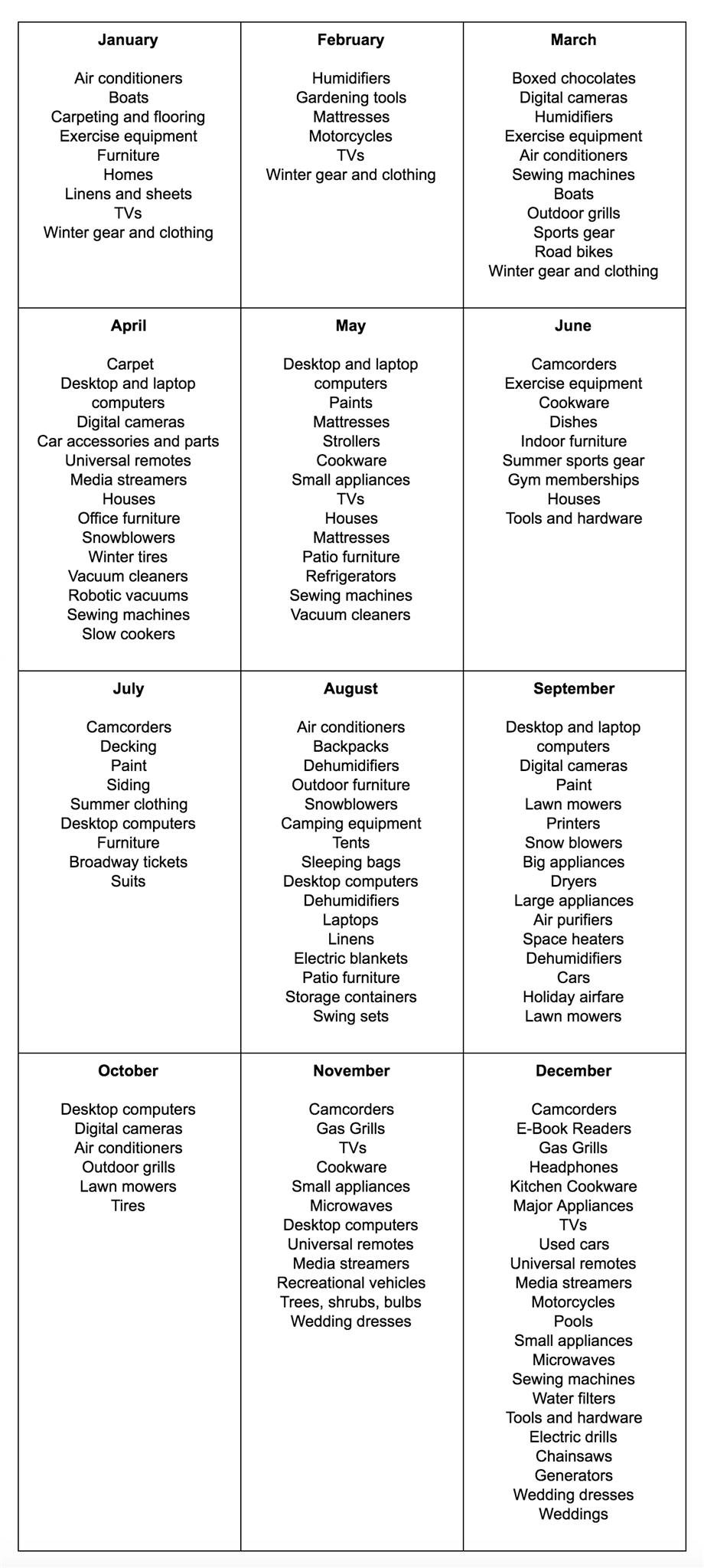Business
Do you have a shopping plan? Here’s the consumer calendar for 2018
Looking for the best deals and discounts? Create your shopping plan and organize the perfect timing on when to wisely spend your money.

Behold, the buying calendar.
It’s the ultimate consumer tool. If you’re planning to spend money in 2018, you need to get organized. Why? Because businesses are.
They know when you’re likely to buy and are constantly trying to manipulate you with a barrage of ads and armies of highly trained sales associates who don’t take “no” for an answer.
“Every year brings with it a few big-ticket purchases, ranging on the scale of need to want,” says Jennifer McDermott, a consumer advocate for finder.com. “Many things can be planned in advance and tracked to ensure you’re buying at the right time for the best price, leveraging sales periods and known best time to buy.”
“To make the most of your budget without compromising quality, plan your large purchases ahead of time.
But enough talk. Here’s the sales calendar you need.

The 2018 sales calendar. (Source: Consumer Reports, Wisebread, Elliott.org)
This exclusive calendar lists the lowest prices on the most popular consumer products. Businesses don’t like buyers who have a plan. They’re harder to manipulate. Which is exactly why you need this calendar.
Here are a few trends many businesses would prefer you don’t know:
- The most favorable conditions for buying products are late and early in the year.
- Generally, businesses like to up the ante from September to January, first with back-to-school specials, then Black Friday, and finally a desperate sale at the end of the year.
- While some products follow an intuitive, seasonal cycle (like apparel), many don’t.
Finder.com crunched the numbers and identified some patterns, too. The earlier months of the year such as January, February and March, offer the best discounts on winter clothing as well as outdoor appliances such as barbeques, because they’re out of season.
“Once June rolls around people are most likely to forget all about their New Year’s resolution to work out more and gyms become more aggressive in their enrollment offers,” says McDermott. “Discounted monthly subscriptions and waived joining fees are all par for the course during this period.
There are also the classic Black Friday and Cyber Monday sales that come around every November. Although a lot of the deals seem exaggerated, you may still be able to sift out a bargain.
Interestingly, large companies are getting into the act, publishing their own deal calendars. But beware: These can easily be turned into a misleading marketing effort that guides you to making a purchase at the wrong time. If you find a calendar, compare it against an objective one provided by a neutral third party like Finder.com, or, ahem, yours truly.
Perhaps the best use of the buying calendar is that it allows you to plan ahead. When you can sit in quiet, asking yourself: Do I really need new lawn furniture? Do I have to have a new boat? That kind of contemplation can be good for your bank account, because it allows you to separate needs from wants. At least in theory, it can save you hundreds, maybe even thousands of dollars.
—
DISCLAIMER: This article expresses my own ideas and opinions. Any information I have shared are from sources that I believe to be reliable and accurate. I did not receive any financial compensation in writing this post, nor do I own any shares in any company I’ve mentioned. I encourage any reader to do their own diligent research first before making any investment decisions.

-

 Biotech5 days ago
Biotech5 days agoAsebio Welcomes the EU Biotech Act as a Boost to Competitiveness and Health Autonomy
-

 Africa2 weeks ago
Africa2 weeks agoBank Al-Maghrib’s Final 2025 Meeting Expected to Maintain Key Interest Rate
-

 Biotech1 day ago
Biotech1 day agoChai Discovery Becomes a Unicorn with $130 Million Series B to Accelerate AI-Driven Drug Design
-

 Africa1 week ago
Africa1 week agoMorocco Allocates 1.3 Billion Dirhams to Boost Startup Ecosystem Under Digital 2030 Strategy


























You must be logged in to post a comment Login